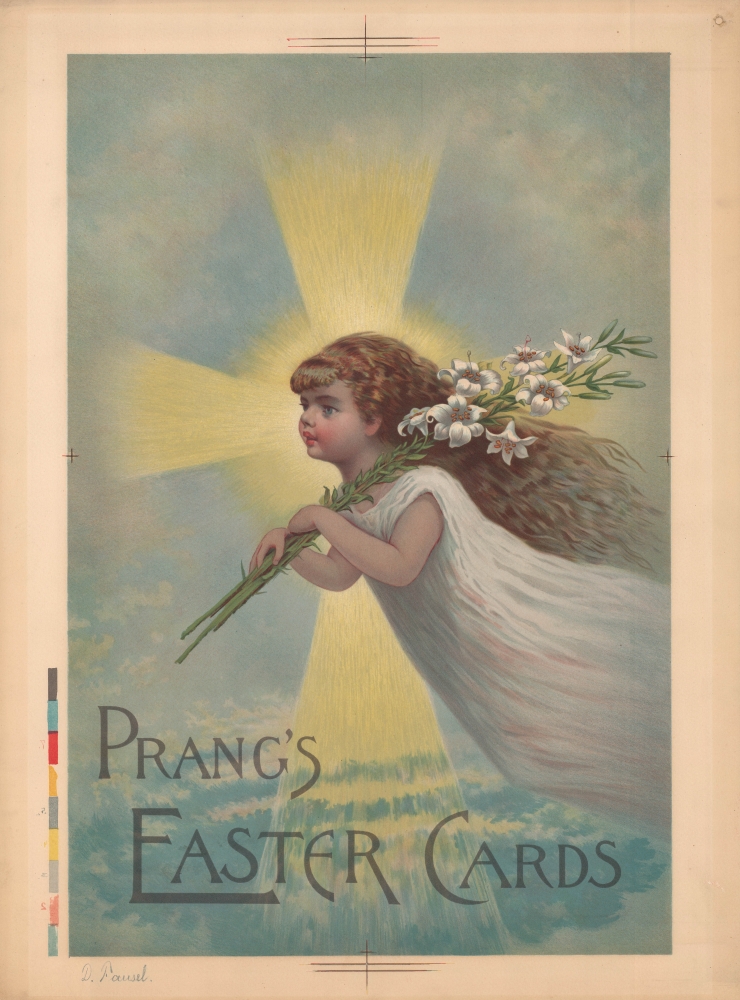1886 Proof Print Advertisement for Prang's Easter Cards - ex. Last
EasterCard-prang-1886
Title
1886 (undated) 20.75 x 13.75 in (52.705 x 34.925 cm)
Description
A Closer Look
An angelic child floats through the sky holding flowers, while behind her sunlight in the shape of a cross illuminates the clouds. This is a proof print for a sheet advertising Prang's Easter Cards, complete with registration marks, made to check whether the stones or plates used for each individual color were properly aligned for the final image. The spectrum on the left and the cross marks at top and bottom were made by the chromist to ensure that the color plates used have lined up correctly, while the hole at top-right was used so that the paper could be lined up in the same place for each color run.Easter Cards
Though they have a history dating back several centuries, Easter Cards became commercially available and commonly used in the late 19th century, largely through the efforts of Prang. The images often contained simple Christian religious imagery, such as angels or crosses (the image used here was likely one of a range of angel images used for the much smaller Easter Cards). Though he did not invent greeting cards, Prang perfected chromolithographic printing and was the first printer to make vividly-colored greeting cards affordable and available on a mass scale. In addition to the Easter Cards advertised here, he is often called the 'father of the American Christmas Card.'Chromolithography
Chromolithography, sometimes called oleography, is a color lithographic technique developed in the mid-19th century. The process involved using multiple lithographic stones, one for each color, to yield a rich composite effect. Oftentimes, the process would start with a black basecoat upon which subsequent colors were layered. Some chromolithographs used 30 or more separate lithographic stones to achieve the desired product. Chromolithograph color could also be effectively blended for even more dramatic results. The process became extremely popular in the late 19th and early 20th centuries, when it emerged as the dominant method of color printing. The vivid color chromolithography produced made it exceptionally effective for advertising and propaganda imagery.Publication History and Census
This proof print was produced by Louis Prang and Co. and checked by chromist D. [Daniel] Fausel around the year 1886. The only other known examples are held by the American Antiquarian Society and the Huntington Library.Cartographer
Louis Prang (March 12, 1824 - September 14, 1909) was a Boston based publisher of lithographs and chromolithographs active in the latter half of the 19th century. Prang was born in Breslau Germany where he studied printmaking and engraving from his father, a noted master of the calico process. Around 1850, Prang immigrated to the United States fearing political persecution in Germany after the failed Springtime of the Peoples Revolution, making him a 48er. In the United States, Prang partnered with another German Printmaker, Julius Mayer, establishing the short-lived Prang & Mayer firm. Ten years later, in 1860, Prang started his own chromolithography firm, L. Prang & Co. Prang quickly established himself as a publisher of post cards and other small prints, which were popular as gifts and collectibles. He was especially successful with mass-produced overviews of major battles in the U.S. Civil War, and his 'War Telegram Marking Map' was memorable for being sold with colored pencils, allowing buyers to track the movement of armies over time. Many consider him to be the "Father of the American Christmas Card". Prang also issued larger format chromolithographs of popular art and even printed his own magazine to the effect Prang's Chromo: A Journal of Popular Art. Through his magazines and limited edition printings, Prang was influential in establishing the popularity of the chromolithographic process in America. More by this mapmaker...

